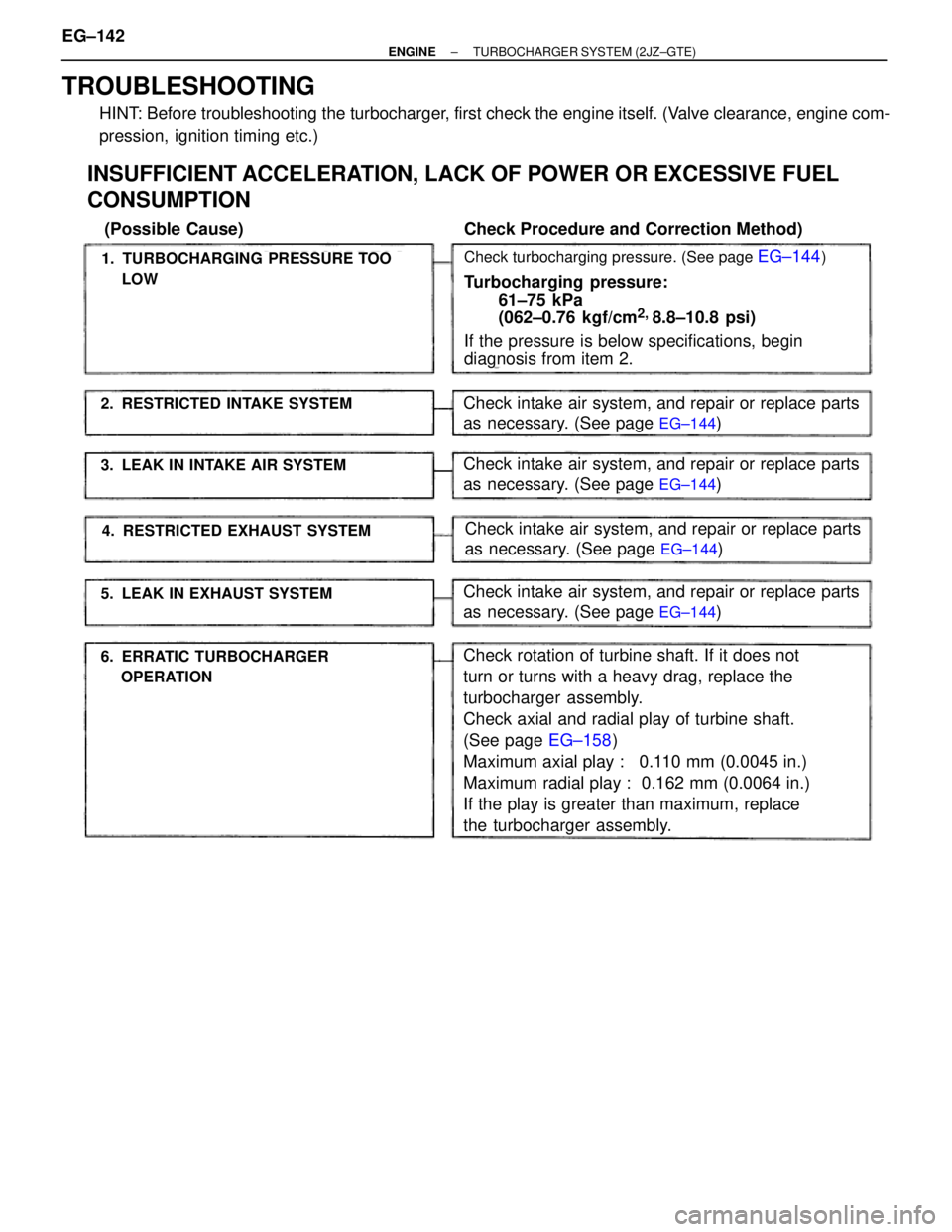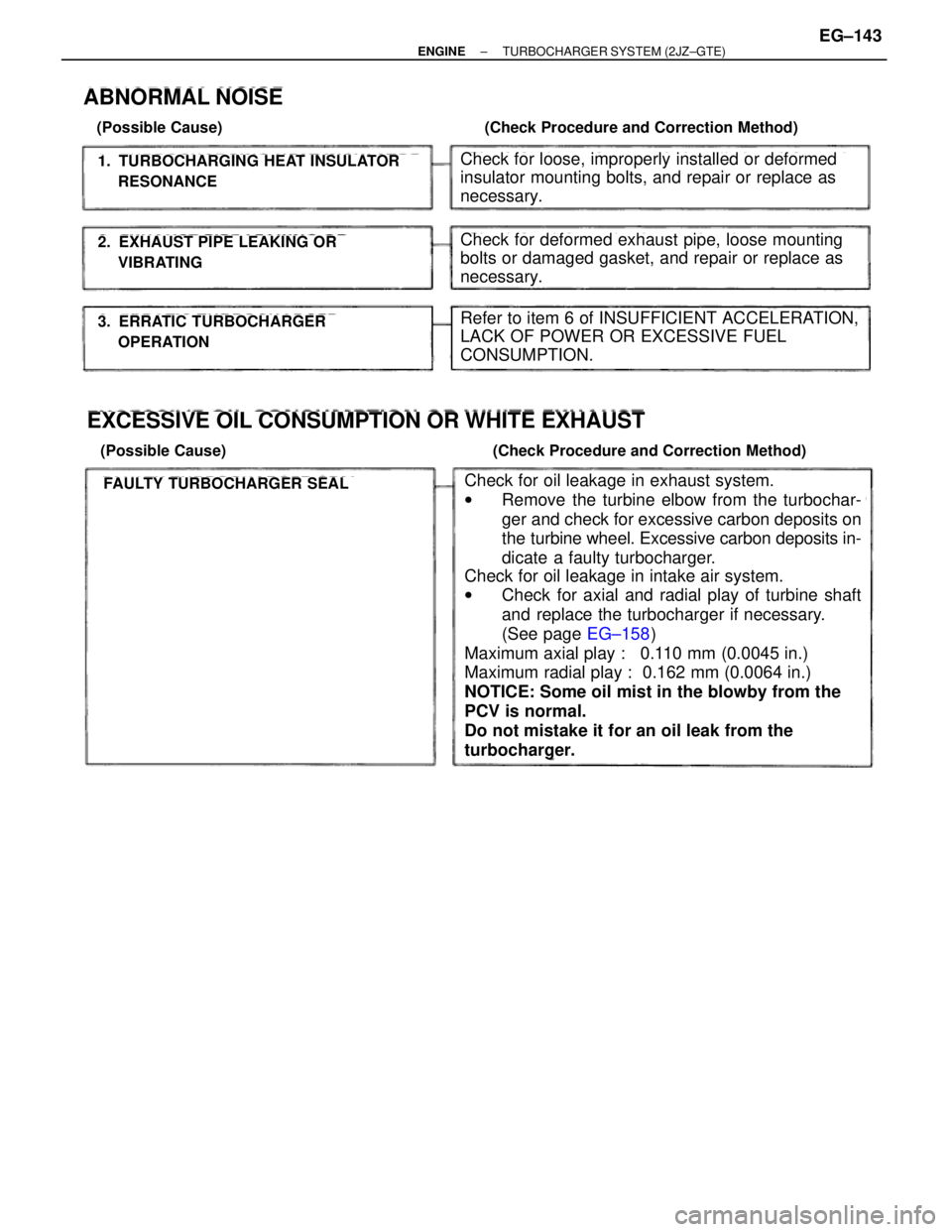fuel consumption TOYOTA SUPRA 1986 Service Repair Manual
[x] Cancel search | Manufacturer: TOYOTA, Model Year: 1986, Model line: SUPRA, Model: TOYOTA SUPRA 1986Pages: 878, PDF Size: 20 MB
Page 3 of 878

TROUBLESHOOTING
HINT: Before troubleshooting the turbocharger, first check the engine itself. (Valve clearance, engine com-
pression, ignition timing etc.)
Check intake air system, and repair or replace parts
as necessary. (See page
EG±144)
1. TURBOCHARGING PRESSURE TOO
LOW
2. RESTRICTED INTAKE SYSTEM
6. ERRATIC TURBOCHARGER
OPERATION
3. LEAK IN INTAKE AIR SYSTEM
4. RESTRICTED EXHAUST SYSTEM
5. LEAK IN EXHAUST SYSTEM
INSUFFICIENT ACCELERATION, LACK OF POWER OR EXCESSIVE FUEL
CONSUMPTION
(Possible Cause) Check Procedure and Correction Method)
Check turbocharging pressure. (See page EG±144)
Turbocharging pressure:
61±75 kPa
(062±0.76 kgf/cm
2,
8.8±10.8 psi)
If the pressure is below specifications, begin
diagnosis from item 2.
Check intake air system, and repair or replace parts
as necessary. (See page
EG±144)
Check intake air system, and repair or replace parts
as necessary. (See page
EG±144)
Check intake air system, and repair or replace parts
as necessary. (See page
EG±144)
Check rotation of turbine shaft. If it does not
turn or turns with a heavy drag, replace the
turbocharger assembly.
Check axial and radial play of turbine shaft.
(See page EG±158)
Maximum axial play : 0.110 mm (0.0045 in.)
Maximum radial play : 0.162 mm (0.0064 in.)
If the play is greater than maximum, replace
the turbocharger assembly. EG±142
± ENGINETURBOCHARGER SYSTEM (2JZ±GTE)
Page 4 of 878

1. TURBOCHARGING HEAT INSULATOR
RESONANCE
2. EXHAUST PIPE LEAKING OR
VIBRATING
3. ERRATIC TURBOCHARGER
OPERATION
ABNORMAL NOISE
(Possible Cause) (Check Procedure and Correction Method)
Check for loose, improperly installed or deformed
insulator mounting bolts, and repair or replace as
necessary.
Check for deformed exhaust pipe, loose mounting
bolts or damaged gasket, and repair or replace as
necessary.
Refer to item 6 of INSUFFICIENT ACCELERATION,
LACK OF POWER OR EXCESSIVE FUEL
CONSUMPTION.
EXCESSIVE OIL CONSUMPTION OR WHITE EXHAUST
(Possible Cause) (Check Procedure and Correction Method)
FAULTY TURBOCHARGER SEALCheck for oil leakage in exhaust system.
wRemove the turbine elbow from the turbochar-
ger and check for excessive carbon deposits on
the turbine wheel. Excessive carbon deposits in-
dicate a faulty turbocharger.
Check for oil leakage in intake air system.
wCheck for axial and radial play of turbine shaft
and replace the turbocharger if necessary.
(See page EG±158)
Maximum axial play : 0.110 mm (0.0045 in.)
Maximum radial play : 0.162 mm (0.0064 in.)
NOTICE: Some oil mist in the blowby from the
PCV is normal.
Do not mistake it for an oil leak from the
turbocharger.
± ENGINETURBOCHARGER SYSTEM (2JZ±GTE)EG±143
Page 392 of 878

COMPRESSION CHECK
HINT: If there is lack of power, excessive oil consumption or
poor fuel economy, measure the compression pressure.
1. WARM UP AND STOP ENGINE
Allow the engine to warm up to normal operating tempera-
ture.
2. 2JZ±GE:
DISCONNECT DISTRIBUTOR CONNECTOR
3. 2JZ±GTE:
DISCONNECT CAMSHAFT POSITION SENSOR CON-
NECTORS
4. 2JZ±GE:
DISCONNECT HIGH±TENSION CORDS FROM SPARK
PLUGS
(See high±tension cords and cord clamps removal in
Ignition System)
5. 2JZ±GTE:
REMOVE IGNITION COILS ASSEMBLIES
(See ignition coils removal in Ignition System)
6. REMOVE SPARK PLUGS
7. CHECK CYLINDER COMPRESSION
(a) Insert a compression tester into the spark plug hole.
(b) Wh ile cra n kin g th e en g in e , me a su re th e co mp re ssio n
pressure.
HINT: Always use a fully charged battery to obtain engine rev-
olutions of 250 rpm or more.
(c) Repeat steps (a) through (b) for each cylinder.
NOTICE: This measurement must be done in as short a time as
possible.
Standard pressure:
2JZ±GE
1,275 kPa (13.0 kgf/cm
2, 185 psi) or more
2JZ±GTE
1,079 kPa (11.0 kgf/cm
2, 156 psi) or more
Minimum pressure:
2JZ±GE
1,079 kPa (11.0 kgf/cm
2, 156 psi)
2JZ±GTE
883 kPa (9.0 kgf/cm
2, 128 psi)
Difference between each cylinder:
98 kPa (1.0 kgf/cm
2, 14 psi) or less
(d) If the cylinder compression in 1 or more cylinders is low, pour
a small amount of engine oil into the cylinder through the
spark plug hole and repeat steps (a) through (b) for the
cylinder with low compression.
± ENGINEENGINE MECHANICALEG±9